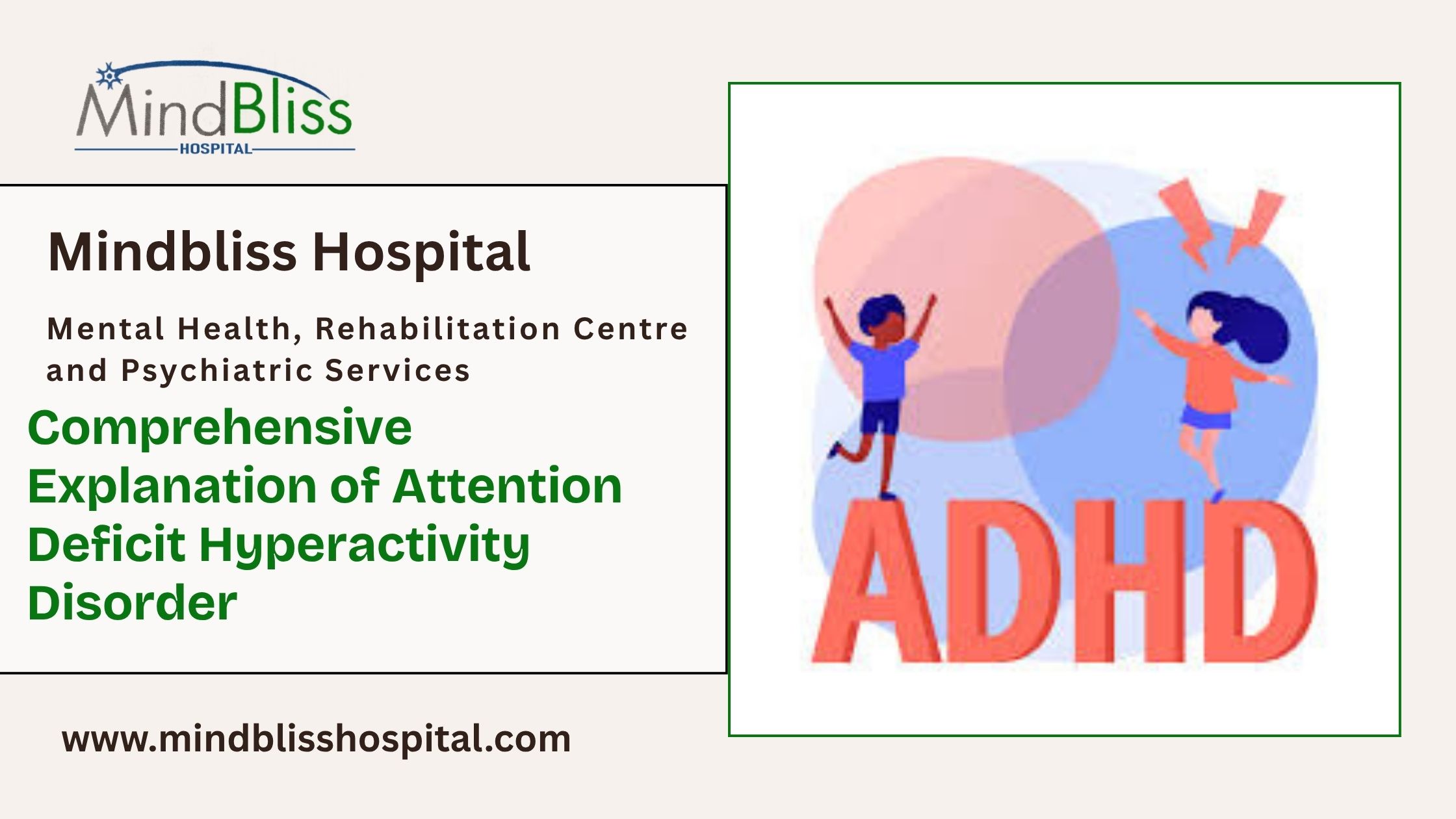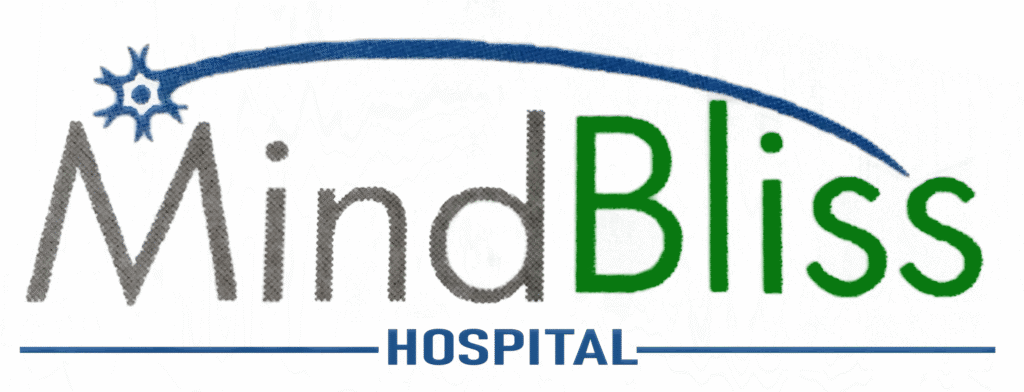
A Comprehensive Explanation of Attention Deficit Hyperactivity Disorder
Attention Deficit Hyperactivity Disorder: Best Guide
Attention Deficit Hyperactivity Disorder (ADHD) is a term you may have heard often. Yet despite its common usage, many people continue to misunderstand what it truly means, how it appears, and what can be done about it. In this article we at Mindbliss Hospital will walk you through what ADHD is, how it develops, how it shows up in children and adults, how it is diagnosed, and what treatment options are available. Our goal is to equip you—whether you are a parent, a teacher, a young adult or simply someone curious—with a clear and compassionate understanding of ADHD and how to approach it sensitively and effectively.
What is ADHD?
ADHD stands for Attention Deficit Hyperactivity Disorder. At its core, it is a neurodevelopmental condition—meaning it emerges early in life and affects the way the brain develops and functions.
In ADHD, individuals experience chronic patterns of inattention, hyperactivity, and impulsivity (though not everyone has all of these). The symptoms are more than just occasional daydreaming or fidgeting: they are persistent, occur in more than one setting (for example home and school), and significantly interfere with daily functioning.
To put simply: imagine a child who struggles to stay focused on homework, often forgets tasks, is restless and fidgety in class; or an adult who has difficulty organising their day, misses deadlines, interrupts others or keeps shifting from one project to another without finishing. These may be signs of ADHD.
Important: ADHD isn’t simply bad behaviour or lack of willpower. It is rooted in brain development and neurological functioning.
Why is ADHD important?
Recognising ADHD matters for several reasons:
- Early detection and help can significantly improve life outcomes—for academics, relationships, self-esteem and daily functioning.
- If unrecognised or untreated, ADHD may lead to frequent difficulties: in school or work, in relationships, in emotional regulation, and may co-occur with other mental health conditions.
- Understanding ADHD correctly helps reduce stigma. Many people dismiss symptoms as simple “laziness” or “carelessness,” but a neuro-developmental lens helps create a compassionate and practical approach.
- For parents, educators, and clinicians: knowing how ADHD presents and behaves allows tailored support, better structured environments, and more effective interventions.
How common is ADHD?
While prevalence varies by region and diagnostic standards, here are some broad estimates:
- In children, roughly 5-15% may meet criteria for ADHD in many studies.
- Among adults, the prevalence is lower but still significant (for example 2-5% in some reports) though many adults remain undetected.
- Historically, more boys than girls were diagnosed in childhood—often because boys present more overt hyperactive/impulsive symptoms, while girls may show more subtle inattentive types.
- ADHD spans the lifespan: symptoms may continue into adulthood or change in form, rather than completely disappearing.
Thus, ADHD is far from rare and deserves attention in healthcare, schools, workplaces and family settings.
Types of ADHD
According to current diagnostic frameworks, ADHD is categorized into three primary presentations:
-
Predominantly Inattentive Presentation
-
Difficulty sustaining attention, easily distracted, forgetful, trouble organising tasks or following through.
-
Often described (especially in children) as “daydreamy,” “quietly unfocused,” or “slow to finish tasks”.
-
-
Predominantly Hyperactive-Impulsive Presentation
-
Excessive fidgeting, restlessness, inability to stay seated, interrupting others, blurting out answers, acting without thinking.
-
-
Combined Presentation
-
A mixture of inattentive symptoms and hyperactive/impulsive symptoms.
-
These types matter because the support strategies may vary depending on which set of symptoms dominates.
What causes ADHD?
Understanding the origins of ADHD helps demystify it. There is no single cause; rather multiple factors combine to raise risk. Key contributors include:
Genetic and neurobiological factors
- ADHD has a strong genetic component: many studies show high heritability (often estimated around 70–80%).
- Differences in brain structure and function have been observed—particularly in regions of the brain involved in attention, impulse control and executive functioning.
- Neurotransmitter systems (e.g., dopamine, norepinephrine) appear to work differently in people with ADHD, affecting things like sustaining attention, controlling impulses, planning and regulating behaviour.
Environmental and perinatal factors
- Prenatal exposure to substances (like alcohol or tobacco), prematurity, low birth weight—all may increase risk.
- Early childhood adversity, toxin exposure, or significant brain injury are also recognised risk or contributing factors.
Diet, lifestyle and behavioural influences
- While diet alone doesn’t cause ADHD, certain behavioural and environmental factors (such as high sugar intake, excessive screen time, poor sleep or chaotic routines) may worsen symptoms or hamper attention regulation.
- Structured environments, consistent routines and good sleep hygiene may reduce the impact of symptoms.
Interaction of factors
- It’s important to think of ADHD as arising from an interplay of biology + environment, rather than being wholly genetic or wholly “caused” by upbringing.
- Also, just because someone has a risk factor (say, prematurity) doesn’t mean they will develop ADHD. The risk is higher, but outcomes vary.
In short: ADHD is about how the brain develops and functions in a particular context—both internal (neurology/genetics) and external (environment/lifestyle) matter.
How does ADHD show up in children?
In children the symptoms may manifest in several settings: home, school, play, social interactions. Here are key features:
Inattention signs
- Difficulty paying attention or sustaining focus (e.g., during class, while doing homework).
- Careless mistakes in schoolwork or activities that require mental effort.
- Seems not to listen when spoken to directly; struggles with following instructions.
- Avoiding or being reluctant to engage in tasks that demand sustained mental effort (like homework).
- Losing things needed for tasks (books, pencils, assignments).
- Easily distracted by extraneous stimuli.
- Forgetful in daily activities.
Hyperactivity & impulsivity signs
- Fidgeting—tapping hands or feet, squirming in seat.
- Difficulty remaining seated when expected (e.g., in class).
- Running around or climbing in situations where it’s inappropriate.
- Difficulty playing quietly.
- Talking excessively.
- Blurting out answers before questions are completed.
- Interrupting or intruding on others’ conversations or games.
- Trouble waiting for their turn.
Additional impacts
- Struggles in school: incomplete homework, missing deadlines, difficulty organising tasks.
- Social issues: may interrupt peers, have trouble with turn-taking or waiting, may be perceived as “too much” or “rude” though this may simply be impulse control issues.
- Emotional side: frustration when unable to keep up, lower self-esteem, feeling “different.”
- Family/home dynamics: parent or siblings may feel the child is constantly moving, unpredictable, or that instructions aren’t being followed.
Crucially, these behaviours must be excessive compared to what is expected for the child’s age/developmental level, and must interfere with their functioning in multiple settings.
How does ADHD appear in adults?
Many people assume ADHD is a childhood issue that goes away—but in many cases the symptoms persist or evolve into adulthood. Adults with ADHD might present differently.
Common adult presentations
- Persistent difficulty with organisation: missed deadlines, bills unpaid, tasks half-done.
- Trouble focusing: jumping between tasks, being easily distracted, difficulty sustaining attention in meetings or reading.
- Impulsivity in behaviour: making quick decisions without full reflection, interrupting others, risky behaviour (e.g., speeding, substance use).
- Restlessness: while hyperactivity may reduce compared to childhood, internal restlessness or feeling unable to relax remains.
- Emotional dysregulation: quick to frustration, mood swings, sensitivity to criticism. Relationship problems: misunderstandings, missed appointments, forgetting commitments.
- Under-achieved potential: despite intelligence or ability, may under-perform relative to expectations.
- Comorbidities: higher rates of anxiety, depression, substance misuse.
Why it matters
For an adult living with undiagnosed ADHD, the cumulative effects can be heavy: frustrated career track, relationship strain, low self-esteem, and greater risk for burnout. Getting diagnosed and treated can make a meaningful difference in quality of life.
ADHD in the Indian context
While much of the research on ADHD comes from Western countries, the condition is equally relevant in India. Here are some considerations for the Indian setting:
- Social awareness: Many children may be labelled “naughty,” “lazy,” or “daydreamer” rather than being assessed for ADHD. Providing awareness to parents, teachers and healthcare professionals is key.
- Educational environment: Indian schools often have high academic demands, long hours and large classes. This makes the attention and organisational difficulties in ADHD more visible and more challenging.
- Stigma: Mental health conditions—including neuro-developmental disorders—can still carry stigma. It is important to approach ADHD with understanding and not blame.
- Resource availability: Access to specialised psychiatrists / psychologists / educational support may vary by region. Early referral and intervention remain critical.
- Cultural differences: The way ADHD is expressed may vary by culture, gender and environment—so local practitioners need culturally sensitive assessment.
At Mindbliss Hospital, we emphasise that ADHD in India is treatable and manageable, not a life sentence. With the right support and structured plan, children and adults can thrive.
How is ADHD diagnosed?
Diagnosis of ADHD is not as simple as one test. It involves gathering information, observing behaviour, ruling out other conditions, and often collaborating across settings (home, school, work). The key steps include:
Clinical interview
A psychiatrist or clinical psychologist will interview the individual (or the parents/teachers, in the case of a child) to obtain a detailed history: onset of symptoms, duration (usually at least 6 months), impact across settings, developmental milestones, previous treatments, comorbidities.
Rating scales & standardised assessments
Standardised questionnaires (e.g., for parents, teachers, adults) help quantify the symptoms and their severity compared to peers.
Behavioural observation
In children especially, direct observation or reviews of behaviour in school and home settings help confirm that symptoms are persistent and impairing.
Ruling out other causes
Because many other conditions mimic or accompany ADHD (for example anxiety disorders, mood disorders, sleep disorders, hearing/vision issues, learning disabilities), part of the diagnostic process is to exclude or account for these.
Cross-setting confirmation
Symptoms must appear in two or more settings (e.g., at home and school or work), and they must interfere with functioning.
Age of onset and developmental context
Typically, symptoms emerge before age 12 (though sometimes they go undetected until later).
Types and specification
The clinician will also specify the presentation type (inattentive, hyperactive-impulsive or combined), severity (mild/moderate/severe) and any comorbid conditions.
Assessment of comorbidity
Since ADHD often co-occurs with other psychiatric issues (for example oppositional defiant disorder, conduct disorder, anxiety, depression, substance use), these need to be recognised and addressed.
In summary: diagnosis of ADHD is comprehensive, and requires skilled evaluation—not merely a parent or teacher observing “he’s fidgety” or “she can’t sit still.”
Why early intervention matters
When ADHD is identified early and support is given, the benefits are substantial. Consider:
- Children receive help in school with organisational skills, improved self-esteem, fewer behavioural problems and better academic outcomes.
- Adults get strategies for workplace efficiency, relationship stability, better emotional regulation, and improved quality of life.
- With early intervention, long-term risks—such as academic under-achievement, substance abuse, difficulty in employment or relationships—can be reduced.
- Structured support also helps reduce frustration for families, teachers and workplaces, making the environment more predictable and manageable.
Thus, at Mindbliss Hospital we emphasise: the sooner you act, the more manageable the trajectory becomes.
Treatment & management of ADHD
ADHD management is multimodal—that is, it combines different types of support rather than relying on just one. The right plan will be tailored to the individual, taking into account age, type of symptoms, comorbidities, and setting.
1. Psycho-education
Understanding ADHD is the first step: for the individual, for the family, for teachers and employers. Clear information demystifies symptoms (“It’s not my fault”), helps reduce blame and fosters collaboration.
2. Behavioural strategies & environmental modifications
Especially in children:
- Structured routines and predictable schedules help provide stability and reduce distraction.
- Breaking tasks into smaller, manageable chunks, and setting timers or reminders.
- Organisational tools: checklists, planners, apps.
- Minimising distractions (e.g., seating away from windows, reducing clutter, limiting screen time).
- Reinforcement of positive behaviour and consistent consequences for impulsivity or disruption.
These tools help reduce the functional impact of ADHD symptoms.
3. Educational/Specialist support
- In schools: customised educational plans (IEPs), preferential seating, extra time for tasks/exams, collaboration between teachers and special educators.
- In the workplace: reasonable accommodations (flexible scheduling, distraction-free workspace, frequent check-ins).
Such support leverages strength areas and reduces disadvantage due to attention/organisational challenges.
4. Medication
Medication often plays an important role, particularly when symptoms are moderate to severe or significantly impairing. Many evidence-based medications exist, including stimulants (methylphenidate, amphetamine salts) and non-stimulants (atomoxetine, guanfacine).
Medication decisions depend on age, comorbidities, side-effect profile, and individual response. At Mindbliss Hospital, medication is always paired with other supports—not used alone.
5. Psychological therapies
- Cognitive behavioural therapy (CBT) and other psychotherapy approaches can help with managing impulsivity, improving organisational skills, addressing comorbid anxiety or depression.
- Parent training programmes (for children) help parents implement consistent strategies and reduce family stress.
- Coaching and skills training for adults around executive functions (time-management, prioritisation, self-monitoring).
The best outcomes come when therapy complements behavioural strategies and medication.
6. Lifestyle interventions
- Physical activity and exercise: helps regulate attention, mood and restlessness.
- Good sleep hygiene: poor sleep worsens ADHD symptoms.
- Healthy diet and limiting excessive screen time: while not a cure, these help reduce aggravating factors.
- Mindfulness and stress-management techniques: especially helpful in adult ADHD to reduce emotional dysregulation.
7. Ongoing monitoring and adjustment
ADHD is not a one-time fix. Regular follow-up is essential: symptom progression, side-effects of medication, changing life demands (school transitions, job changes), comorbidities—all mean the care plan may need adjustment. At Mindbliss Hospital we emphasise a dynamic care plan, not “set-and-forget”.
Conclusion
At Mindbliss Hospital our philosophy is clear: ADHD is not a weakness—it is a difference. With the right understanding, support and strategies, people with ADHD can and do thrive. Whether you are the parent of a child struggling with attention and hyperactivity, an adult navigating organisational challenges, a teacher seeking to support your students, or simply someone wanting to learn more—this article is your starting point.










